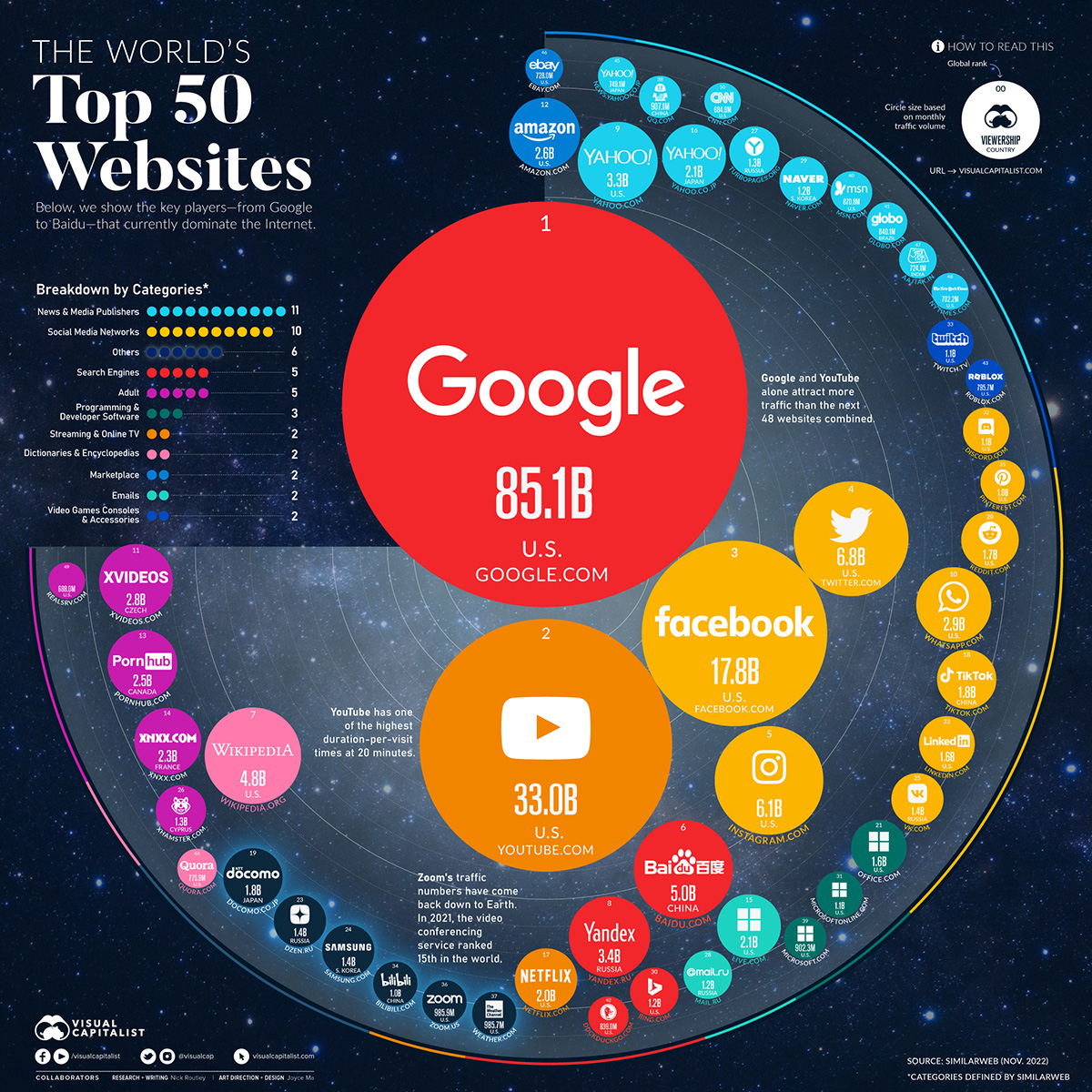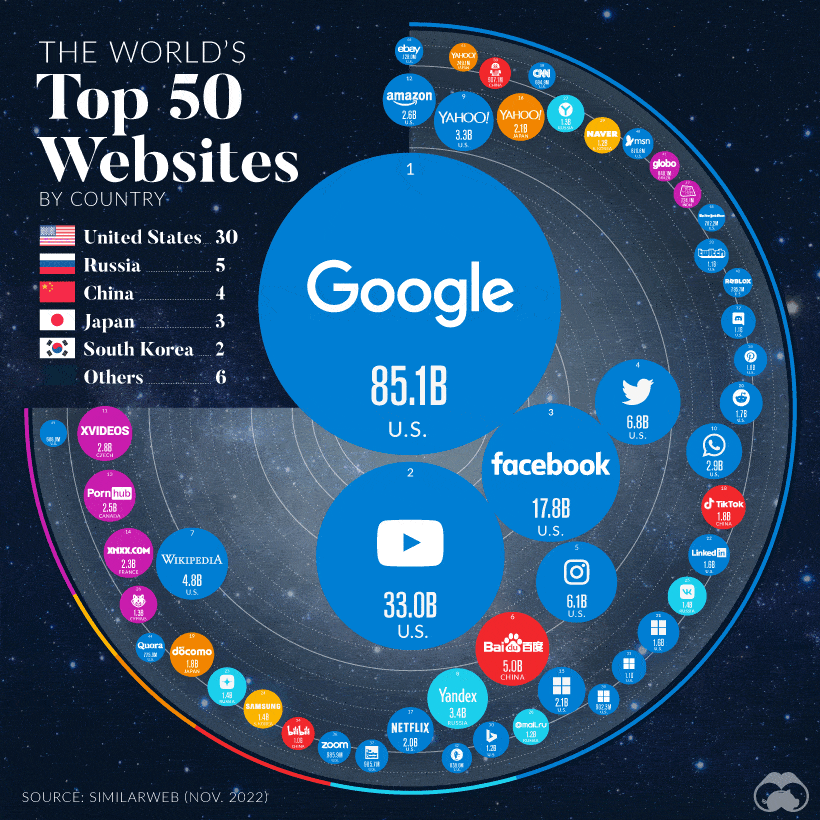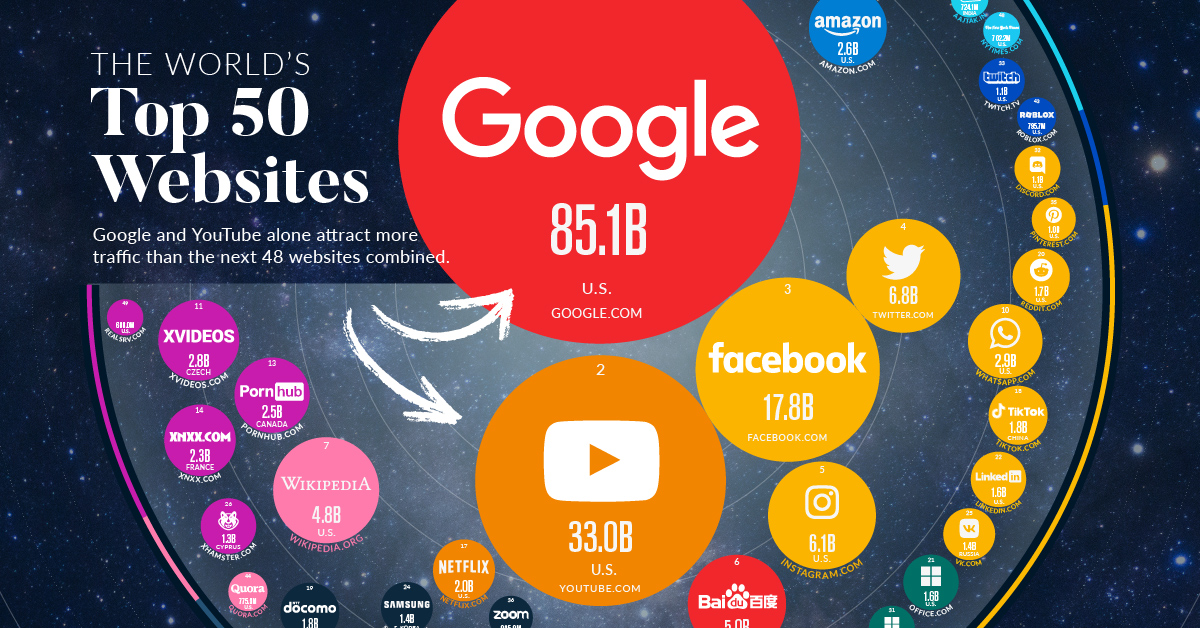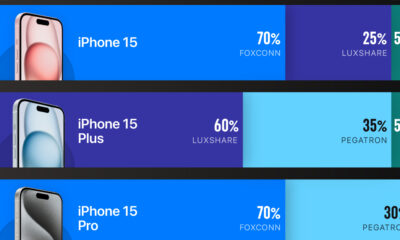Technology
Ranked: The Top 50 Most Visited Websites in the World
View the full-resolution version of this infographic
Ranked: The Top 50 Most Visited Websites in the World
Estimates vary, but there are upwards of two billion websites in existence in 2023.
If we were to rank all of these websites according to their traffic numbers, we would see a classic power law distribution. At the low end, the vast majority of these websites would be inactive, receiving little to no traffic. On the upper end of the ranking though, a handful of websites receive the lion’s share of internet traffic.
This visualization, using data from SimilarWeb, takes a look at the 50 websites that currently sit at the top of the ranking.
Which Websites Get the Most Traffic?
Topping the list of most-visited websites in the world is, of course, Google. With over 3.5 billion searches per day, Google has cemented its position as the go-to source for information on the internet. But Google’s dominance doesn’t stop there. The company also owns YouTube, the second-most popular website in the world. Together, Google and YouTube have more traffic than the next 48 websites combined.
The power of YouTube, in particular, is sometimes not fully understood. The video platform is the second largest search engine in the world after Google. As well, YouTube has the second highest duration-of-visit numbers in this top 50 ranking. (First place goes to the Chinese video sharing website, Bilibili.)
But Google and YouTube aren’t the only big players on the internet. Other websites in the top 50 ranking include social media giants Facebook, Instagram, and TikTok. In particular, TikTok has seen a surge in popularity in recent years and is now one of the most popular social media platforms in the world.
Here’s the full top 50 ranking table form:
| Rank | Website | Monthly Traffic | Category | Country |
|---|---|---|---|---|
| #1 | google.com | 85.1B | Search Engines | 🇺🇸 U.S. |
| #2 | youtube.com | 33.0B | Streaming & Online TV | 🇺🇸 U.S. |
| #3 | facebook.com | 17.8B | Social Media Networks | 🇺🇸 U.S. |
| #4 | twitter.com | 6.8B | Social Media Networks | 🇺🇸 U.S. |
| #5 | instagram.com | 6.1B | Social Media Networks | 🇺🇸 U.S. |
| #6 | baidu.com | 5.0B | Search Engines | 🇨🇳 China |
| #7 | wikipedia.org | 4.8B | Dictionaries & Encyclopedias | 🇺🇸 U.S. |
| #8 | yandex.ru | 3.4B | Search Engines | 🇷🇺 Russia |
| #9 | yahoo.com | 3.3B | News & Media Publishers | 🇺🇸 U.S. |
| #10 | whatsapp.com | 2.9B | Social Media Networks | 🇺🇸 U.S. |
| #11 | xvideo.com | 2.8B | Adult | 🇨🇿 Czechia |
| #12 | amazon.com | 2.6B | Marketplace | 🇺🇸 U.S. |
| #13 | pornhub.com | 2.5B | Adult | 🇨🇦 Canada |
| #14 | xnxx.com | 2.3B | Adult | 🇫🇷 France |
| #15 | live.com | 2.1B | 🇺🇸 U.S. | |
| #16 | yahoo.co.jp | 2.1B | News & Media Publishers | 🇯🇵 Japan |
| #17 | netflix.com | 2.0B | Streaming & Online TV | 🇺🇸 U.S. |
| #18 | tiktok.com | 1.8B | Social Media Networks | 🇨🇳 China |
| #19 | docomo.ne.jp | 1.8B | Telecommunications | 🇯🇵 Japan |
| #20 | reddit.com | 1.7B | Social Media Networks | 🇺🇸 U.S. |
| #21 | office.com | 1.6B | Prog. & Developer Software | 🇺🇸 U.S. |
| #22 | linkedin.com | 1.6B | Social Media Networks | 🇺🇸 U.S. |
| #23 | dzen.ru | 1.4B | Faith & Beliefs | 🇷🇺 Russia |
| #24 | samsung.com | 1.4B | Consumer Electronics | 🇰🇷 S. Korea |
| #25 | vk.com | 1.4B | Social Media Networks | 🇷🇺 Russia |
| #26 | xhamster.com | 1.3B | Adult | 🇨🇾 Cyprus |
| #27 | turbopages.org | 1.3B | News & Media Publishers | 🇷🇺 Russia |
| #28 | mail.ru | 1.2B | 🇷🇺 Russia | |
| #29 | naver.com | 1.2B | News & Media Publishers | 🇰🇷 S. Korea |
| #30 | bing.com | 1.2B | Search Engines | 🇺🇸 U.S. |
| #31 | microsoftonline.com | 1.1B | Prog. & Developer Software | 🇺🇸 U.S. |
| #32 | discord.com | 1.1B | Social Media Networks | 🇺🇸 U.S. |
| #33 | twitch.tv | 1.1B | Gaming & Accessories | 🇺🇸 U.S. |
| #34 | bilibili.com | 1.0B | Animations & Comics | 🇨🇳 China |
| #35 | pinterest.com | 1.0B | Social Media Networks | 🇺🇸 U.S. |
| #36 | zoom.us | 985.9M | Computers Electronics & Tech | 🇺🇸 U.S. |
| #37 | weather.com | 985.7M | Weather | 🇺🇸 U.S. |
| #38 | qq.com | 907.1M | News & Media Publishers | 🇨🇳 China |
| #39 | microsoft.com | 902.3M | Prog. & Developer Software | 🇺🇸 U.S. |
| #40 | msn.com | 870.8M | News & Media Publishers | 🇺🇸 U.S. |
| #41 | globo.com | 840.1M | News & Media Publishers | 🇧🇷 Brazil |
| #42 | duckduckgo.com | 839.0M | Search Engines | 🇺🇸 U.S. |
| #43 | roblox.com | 795.7M | Gaming & Accessories | 🇺🇸 U.S. |
| #44 | quora.com | 775.9M | Dictionaries & Encyclopedias | 🇺🇸 U.S. |
| #45 | news.yahoo.co.jp | 749.1M | News & Media Publishers | 🇯🇵 Japan |
| #46 | ebay.com | 728.0M | Marketplace | 🇺🇸 U.S. |
| #47 | aajtak.in | 724.1M | News & Media Publishers | 🇮🇳 India |
| #48 | nytimes.com | 702.2M | News & Media Publishers | 🇺🇸 U.S. |
| #49 | realsrv.com | 688.0M | Adult | 🇺🇸 U.S. |
| #50 | cnn.com | 684.9M | News & Media Publishers | 🇺🇸 U.S. |
Notable companies that have fallen out of the top 50 since our last version of this visualization are Walmart and PayPal. Notable entrants into the top 50 are Samsung and the New York Times.
The Geography of the 50 Most-Visited Websites
The United States is still home base for many of the world’s biggest websites, taking up 30 spots on this ranking. Of these 30 websites, half are operated by Big Tech companies such as Microsoft, Amazon, Alphabet, Meta, and Netflix.
Russia, China, Japan, and South Korea round out the top five.
Things get interesting in the “other” category, which includes six websites. Two spots are taken up by Aaj Tak and Globo, which are large media publications in India and Brazil, respectively.
The remaining four websites—XVideos, PornHub, XHamster, and XNXX—specialize in adult content, and are located in a variety of countries. These are often referred to as “tube sites” since they are built on the YouTube model.
Realsrv, the only adult-oriented site in the top 50 located in the U.S., is interesting to delve into as well, since it’s far from a household name. The website essentially supports advertising efforts by redirecting users away from the content they were viewing over to another page (generally premium adult content). This is one of the key ways that adult websites earn revenue.
Where does this data come from?
Source: SimilarWeb
Notes: Websites listed include “all meaningful subdomains”, and categories in the graphic follow SimilarWeb’s categorization system. This is the third version of this graphic. As with previous versions, we aim to use data from November for the sake of consistency and to avoid seasonal fluctuations in traffic. One important detail to point out is that website traffic does not include app traffic, which is why popular platforms like WeChat don’t appear in this ranking.
Technology
All of the Grants Given by the U.S. CHIPS Act
Intel, TSMC, and more have received billions in subsidies from the U.S. CHIPS Act in 2024.

All of the Grants Given by the U.S. CHIPS Act
This was originally posted on our Voronoi app. Download the app for free on iOS or Android and discover incredible data-driven charts from a variety of trusted sources.
This visualization shows which companies are receiving grants from the U.S. CHIPS Act, as of April 25, 2024. The CHIPS Act is a federal statute signed into law by President Joe Biden that authorizes $280 billion in new funding to boost domestic research and manufacturing of semiconductors.
The grant amounts visualized in this graphic are intended to accelerate the production of semiconductor fabrication plants (fabs) across the United States.
Data and Company Highlights
The figures we used to create this graphic were collected from a variety of public news sources. The Semiconductor Industry Association (SIA) also maintains a tracker for CHIPS Act recipients, though at the time of writing it does not have the latest details for Micron.
| Company | Federal Grant Amount | Anticipated Investment From Company |
|---|---|---|
| 🇺🇸 Intel | $8,500,000,000 | $100,000,000,000 |
| 🇹🇼 TSMC | $6,600,000,000 | $65,000,000,000 |
| 🇰🇷 Samsung | $6,400,000,000 | $45,000,000,000 |
| 🇺🇸 Micron | $6,100,000,000 | $50,000,000,000 |
| 🇺🇸 GlobalFoundries | $1,500,000,000 | $12,000,000,000 |
| 🇺🇸 Microchip | $162,000,000 | N/A |
| 🇬🇧 BAE Systems | $35,000,000 | N/A |
BAE Systems was not included in the graphic due to size limitations
Intel’s Massive Plans
Intel is receiving the largest share of the pie, with $8.5 billion in grants (plus an additional $11 billion in government loans). This grant accounts for 22% of the CHIPS Act’s total subsidies for chip production.
From Intel’s side, the company is expected to invest $100 billion to construct new fabs in Arizona and Ohio, while modernizing and/or expanding existing fabs in Oregon and New Mexico. Intel could also claim another $25 billion in credits through the U.S. Treasury Department’s Investment Tax Credit.
TSMC Expands its U.S. Presence
TSMC, the world’s largest semiconductor foundry company, is receiving a hefty $6.6 billion to construct a new chip plant with three fabs in Arizona. The Taiwanese chipmaker is expected to invest $65 billion into the project.
The plant’s first fab will be up and running in the first half of 2025, leveraging 4 nm (nanometer) technology. According to TrendForce, the other fabs will produce chips on more advanced 3 nm and 2 nm processes.
The Latest Grant Goes to Micron
Micron, the only U.S.-based manufacturer of memory chips, is set to receive $6.1 billion in grants to support its plans of investing $50 billion through 2030. This investment will be used to construct new fabs in Idaho and New York.
-

 Education1 week ago
Education1 week agoHow Hard Is It to Get Into an Ivy League School?
-

 Technology2 weeks ago
Technology2 weeks agoRanked: Semiconductor Companies by Industry Revenue Share
-

 Markets2 weeks ago
Markets2 weeks agoRanked: The World’s Top Flight Routes, by Revenue
-

 Demographics2 weeks ago
Demographics2 weeks agoPopulation Projections: The World’s 6 Largest Countries in 2075
-

 Markets2 weeks ago
Markets2 weeks agoThe Top 10 States by Real GDP Growth in 2023
-

 Demographics2 weeks ago
Demographics2 weeks agoThe Smallest Gender Wage Gaps in OECD Countries
-

 Economy2 weeks ago
Economy2 weeks agoWhere U.S. Inflation Hit the Hardest in March 2024
-

 Green2 weeks ago
Green2 weeks agoTop Countries By Forest Growth Since 2001



















